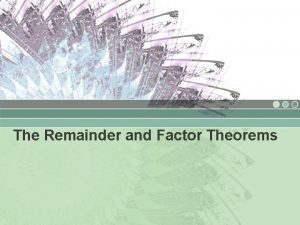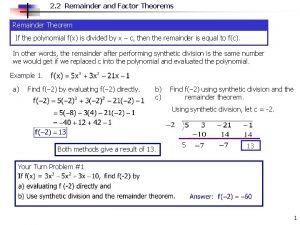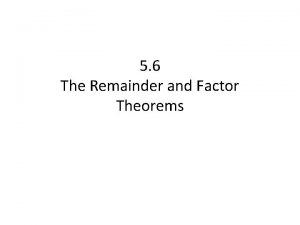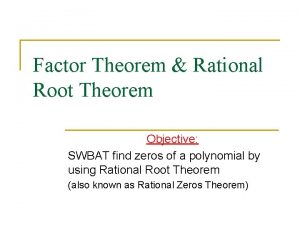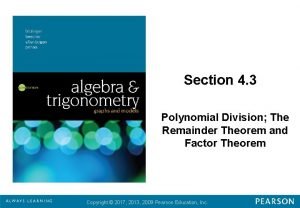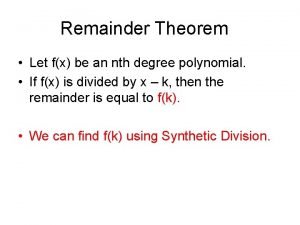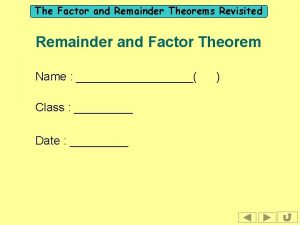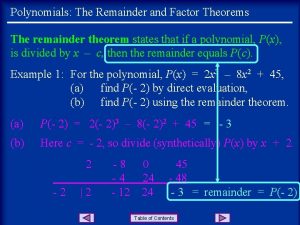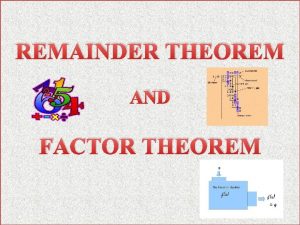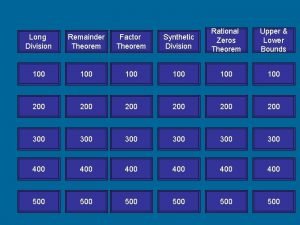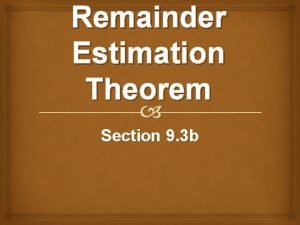2 2 Remainder and Factor Theorems Remainder Theorem








- Slides: 8

2. 2 Remainder and Factor Theorems Remainder Theorem If the polynomial f(x) is divided by x c, then the remainder is equal to f(c). In other words, the remainder after performing synthetic division is the same number we would get if we replaced c into the polynomial and evaluated the polynomial. Example 1. a) Find f( 2) by evaluating f( 2) directly. b) c) Find f( 2) using synthetic division and the remainder theorem. Using synthetic division, let c = -2. Both methods give a result of 13. 5 13 Your Turn Problem #1 1

2. 2 Remainder and Factor Theorems a) Find f(2) by evaluating f(2) directly. b) c) Find f(2) using synthetic division and the remainder theorem. Using synthetic division, let c = 2. 2 4 8 16 32 64 4 8 16 32 61 Both methods give a result of 61. Your Turn Problem #2 2

2. 2 Remainder and Factor Theorems Factor Theorem A polynomial f(x) has a factor x c if and only if f(c) = 0. In other words, if the remainder after performing synthetic division is zero or the result from evaluating the polynomial at c is zero, then x c is a factor. We can use two different methods to answer the question. Either evaluate f(c) directly or use synthetic division. We’ll first evaluate f(c) directly. We are given x 3. Therefore use c = 3. Answer: Yes. If f(c) = 0, then the divisor is a factor of the polynomial The other method we can use is synthetic division. Often this method is more preferable because we can obtain more information than just the remainder. Show by using synthetic division. We are given x + 3. Therefore use c = 3. 1 Answer: Yes, f( 3) = 0. Next Slide 0 3

2. 2 Remainder and Factor Theorems Your Turn Problem #3 Show by evaluating f(c) directly. Answer: No, f(-3) =-6. Show using synthetic division. Answer: Yes, since f(2)=0. 1 0 4

2. 2 Remainder and Factor Theorems Let’s look further at the last your turn problem. Recall from the previous section, the bottom row gives us the quotient. 1 0 We can then write the polynomial completely factored as: Procedure: To factor a polynomial P(x) given a factor x c. 1. 2. 3. 4. Use synthetic division to show x c is a factor of P(x) by showing remainder = 0. Rewrite the quotient in proper form with variables. Factor the quotient (if possible) using previous factoring techniques. The polynomial P(x) completely factored = (x c)(quotient factored) Next Slide 5

2. 2 Remainder and Factor Theorems Example 4. Show g(x) is a factor of f(x) and complete the factorization of f(x). Solution: 1 st, show g(x) is a factor of f(x). 2 nd, rewrite the quotient in proper form. 3 rd, factor the quotient. 1 0 Show the complete factorization. Your Turn Problem #4 Show g(x) is a factor of f(x) and complete the factorization of f(x). 6

2. 2 Remainder and Factor Theorems Example 5. Show g(x) is a factor of f(x) and complete the factorization of f(x). Solution: 1 st, show g(x) is a factor of f(x). 2 nd, rewrite the quotient in proper form. 3 rd, factor the quotient. Show the complete factorization. 6 0 Your Turn Problem #5 Show g(x) is a factor of f(x) and complete the factorization of f(x). 7

2. 2 Remainder and Factor Theorems Example 6. Show g(x) is a factor of f(x) and complete the factorization of f(x). Solution: 1 1 0 0 0 16 0 0 0 16 0 Your Turn Problem #6 Show g(x) is a factor of f(x) and complete the factorization of f(x). The End. B. R. 3 -5 -07 8
